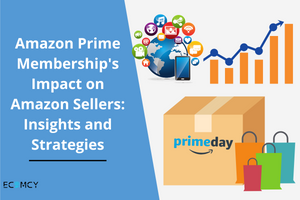Amazon Prime Membership's Impact on Amazon Sellers: Insights and Strategies
September 10, 2023

Amazon Prime, a subscription-based service offered by Amazon, has become an integral part of the online shopping landscape. While it was initially designed to provide customers with benefits like expedited shipping and access to streaming content, its impact extends beyond consumers. Amazon Prime's influence is profound on the countless sellers that operate on Amazon's platform. In this article, we will delve deeper into how Amazon Prime membership affects Amazon sellers and explore the strategies they can employ to not just survive but thrive in this evolving e-commerce ecosystem.
Increased Customer Expectations
Amazon Prime members are known for their high expectations when it comes to their online shopping experiences. They have grown accustomed to receiving their orders in as little as two days and expect a seamless and hassle-free shopping process. This presents both challenges and opportunities for Amazon sellers.
Challenges:
- Logistics and Fulfillment Costs: Meeting the stringent Prime delivery standards can be expensive for sellers. The costs associated with fast shipping, including shipping fees, warehousing, and expedited order processing, can eat into profit margins.
- Inventory Management: Maintaining sufficient stock levels to consistently meet the two-day delivery promise can be challenging. Overstocking may tie up capital, while understocking can lead to missed sales opportunities.
- Competitive Pressure: With Prime-eligible listings receiving priority in search results, non-Prime sellers face increased competition. It can be challenging for them to stand out and attract customers who expect fast shipping.
- Returns and Customer Service: Prime members have the expectation of hassle-free returns, and sellers must be prepared to handle these efficiently. Managing returns and addressing customer service inquiries can be time-consuming and resource-intensive.
Opportunities:
- Increased Sales and Market Share: Prime-eligible products often see a boost in sales due to the "Prime" badge, which attracts customers looking for fast shipping and reliability. Sellers who consistently meet Prime standards can capture a larger share of the market.

- Amazon Prime Pantry and Fresh: Sellers specializing in grocery and household items can benefit from Amazon Prime Pantry and Fresh, which cater to Prime members. These programs open up new market segments and opportunities for niche product categories.
- International Expansion: Amazon Prime is available in multiple countries. Sellers who meet Prime standards can expand their reach to international markets and tap into a global customer base.
- Repeat Business and Loyalty: Prime members often become loyal customers, making repeat purchases. By offering exceptional service and high-quality products, sellers can build long-term relationships with Prime customers, leading to consistent revenue streams.
- Cross-Promotions and Bundling: Sellers can take advantage of the Prime ecosystem by bundling their products with others or running cross-promotions with other Prime-eligible listings. This strategy can increase visibility and sales.
- Fulfillment by Amazon (FBA): While FBA presents challenges like storage fees, it offers sellers the opportunity to tap into Amazon's logistics expertise, ensuring timely deliveries and meeting Prime standards.
Eligibility for Amazon Prime
To harness Amazon Prime's vast and lucrative customer base, many Amazon sellers choose to participate in the Fulfillment by Amazon (FBA) program. When sellers opt for FBA, Amazon handles various aspects of their business, including storage, packing, and shipping of their products, making them eligible for Prime benefits.
Advantages of FBA for Amazon Sellers
- Prime Eligibility: FBA products automatically become Prime-eligible, which can significantly increase visibility and sales potential.
- Reduced Workload: Amazon takes care of customer returns and handles customer service inquiries, lightening the seller's workload.
- Access to Prime Day: FBA products may qualify for Amazon Prime Day promotions and deals, further enhancing their visibility and potential sales.
Competitive Advantage
Having Prime-eligible products gives sellers a considerable competitive advantage in the Amazon marketplace. When customers filter their searches to display only Prime-eligible items, your products are more likely to be seen, leading to increased visibility and, subsequently, potential sales.
Tips for Maximizing Competitive Advantage:
- Optimize Listings: Ensure product listings are of high quality with compelling images, accurate descriptions, and competitive pricing.
- Amazon Advertising: Utilize Amazon Advertising to promote Prime-eligible products, increasing their visibility within Amazon's ecosystem.
- Inventory Management: Monitor inventory levels closely to ensure products remain Prime-eligible and can be consistently fulfilled within Prime's stringent timeframes.
Amazon Prime Day
Amazon Prime Day is a significant shopping event that offers exclusive deals and discounts exclusively to Prime members. It has evolved into a global shopping phenomenon and presents a unique opportunity for Amazon sellers to boost their sales.
Strategies for Amazon Prime Day:
1. Planning Ahead
- Inventory Preparation: Analyze historical sales data and anticipated demand trends to estimate the quantity of products you'll need for Prime Day. Stock up on inventory well in advance to ensure you have sufficient stock to meet the expected surge in demand.
-
Warehouse and Fulfillment: Work closely with your fulfillment center or consider using Amazon's Fulfillment by Amazon (FBA) service to ensure timely and efficient order processing. Amazon's extensive logistics network can help you meet Prime Day delivery expectations.
- Promotion Schedule: Create a detailed schedule for promotions and deals during Prime Day. Consider running "countdown" deals in the days leading up to the event to build anticipation and attract early shoppers.
2. Competitive Deals
- Deep Discounts: Offer substantial discounts on select products to capture the attention of budget-conscious Prime members. The bigger the discount, the more likely your products are to stand out during the event.
- Bundle Offers: Create bundles of related products and offer them at a discounted price. Bundles can entice customers looking for added value.
- Flash Sales: Schedule limited-time flash sales throughout Prime Day. Prominently display countdown timers on your product listings to create a sense of urgency and encourage immediate purchases.
-
Tiered Discounts: Consider offering tiered discounts where customers can save more by purchasing multiple items. As an illustration, consider offering discounts like "Purchase 2 items, and enjoy a 10% reduction; Buy 3 items, and receive a 15% discount.
3. Listing Optimization
- Compelling Images: Ensure your product images are of high quality and clearly showcase your products. Use multiple images from different angles and include lifestyle shots to help customers visualize your products.
- Keyword Optimization: Research and incorporate relevant keywords into your product listings. Use Amazon's keyword tools to identify high-converting search terms.
- Engaging Descriptions: Craft compelling product descriptions that highlight key features and benefits. Use persuasive language to convince customers that your product is a must-have.
- User-Generated Content: Encourage customers to leave reviews and upload photos of your products. Positive reviews and user-generated content build trust and can influence purchasing decisions.
4. Advertising and Promotion
- Amazon Sponsored Products: Invest in Amazon Sponsored Products campaigns to increase the visibility of your Prime Day deals. Allocate a larger budget to these campaigns during the event.
- External Marketing: Promote your Prime Day deals on social media, email newsletters, and your website. Consider using paid advertising on platforms like Facebook and Google to drive traffic to your Amazon listings.
- Early Access: Offer exclusive early access to your Prime Day deals to loyal customers who have subscribed to your newsletter or joined your brand's loyalty program.
5. Monitor and Adjust
- Real-Time Monitoring: Keep a close eye on your sales and inventory levels throughout Prime Day. Adjust your promotion strategy based on real-time data to maximize sales and avoid running out of stock.
- Competitor Analysis: Monitor your competitors' Prime Day deals and adjust your pricing and promotions accordingly. Be prepared to respond to changing market conditions.
- Customer Engagement: Respond promptly to customer inquiries and feedback during the event. Providing outstanding customer service has the potential to result in favorable reviews and customers returning for future transactions.
By implementing these strategies and staying agile during Amazon Prime Day, sellers can leverage this major shopping event to boost sales, attract new customers, and enhance their brand's visibility on the platform. Prime Day presents a golden opportunity to create momentum that can carry over into sustained growth throughout the year.
Conclusion
Amazon Prime membership wields a profound influence on Amazon sellers, shaping customer expectations and offering substantial opportunities for increased visibility and sales. By diligently meeting Prime delivery standards, participating in FBA, and strategically preparing for events like Prime Day, sellers can harness the power of Prime to not only survive but thrive in this competitive marketplace. Adapting to the evolving expectations of Prime members is not just advisable; it's crucial for long-term success as an Amazon seller. Embracing Amazon Prime's impact can propel sellers to new heights in the world of e-commerce.
Leave a comment
Comments will be approved before showing up.




